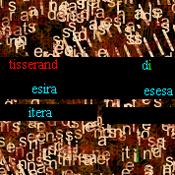webwork 3
LES TISSERANDS,
by Alexandre GHERBAN (France), 2002...
 Les Tisserands ["the weavers"] are part of a colony1, as one might speak of a colony of foreign bodies, insects, or microbes, subject to observation and experiment. The work first presents itself to the visitor as a black screen on which lateral lines of various colours appear, like bacteria under a microscope. Visitors may then click on one of these lines and type a word (or series of words), and thus breathe life (the word) into this colony sample. The words then come to life, move, drawing arabesques of various colours, while the typed-in word or words come apart and regroup, crossing and intersecting, generating associations of letters or phonemes, like so many variations, offshoots, and (in extreme cases) mutations of the original word.
Les Tisserands ["the weavers"] are part of a colony1, as one might speak of a colony of foreign bodies, insects, or microbes, subject to observation and experiment. The work first presents itself to the visitor as a black screen on which lateral lines of various colours appear, like bacteria under a microscope. Visitors may then click on one of these lines and type a word (or series of words), and thus breathe life (the word) into this colony sample. The words then come to life, move, drawing arabesques of various colours, while the typed-in word or words come apart and regroup, crossing and intersecting, generating associations of letters or phonemes, like so many variations, offshoots, and (in extreme cases) mutations of the original word.
In so doing, the elements coming and going and crisscrossing on the screen weave a veritable tapestry, rich and colourful, that recalls both oriental carpets (by the richness and brilliance of the colours) and the works of Jackson Pollock (by a freedom in the stroke that recalls his famous dripping method); it also suggests the ceaseless and (for us) senseless to-and-fro of ants that we observe under glass, rushing about, burrowing tunnels, etc. Thus, before the work - or rather, to use Gherban's terminology, before the observable transitory that appears on the screen2 -, the visitor is tempted to see therein the outcome of concerted design, while also having the feeling of watching the creation of a free-form, playful, and random drawing - all the more so because, here, words are broken down to there value as non-signifying signifiers, visible signs, traces.
Thus, the weavers of the title can be imagined as small, busy, anonymous workers, representatives of the code at work in the work. At once free and predestined - not subjugated to the will of an organizational authority, but nevertheless dependent on the program whose function it is to spawn possibilities and to engender forms and situations, which may be similar - as those of a net that draws a fabric of ever-greater complexity within the frame of a rectangle -, yet are peculiar and surprising every time.

Notes
1 : LA COLONIE
General Description:
Nourished by ideas derived from artificial life, a set of programmed animations that functions as a many-layered "colony" with many points of entry.
Our preoccupation is to define a particular field of study based on the hypothesis that underlying the artistic universe are connections as highly ordered as those found in life, although much less obvious. First starting from a "common trunk" - artificial life -, it is then a question of separating the "colony" from any simplistic simulation life, of exploring all the possibilities of an aesthetic universe that coincides with no preexisting model. To envisage aesthetically specific situations in which the materials (the programming) create forms and situations artistically relevant within a consistent and constantly renewed digital framework. A "colony," therefore, which takes as starting point elementary living situations (as posited by artificial life) to go toward an artistic zone specifically defined by the digital universe: in other words, toward observable transitory forms.
Technical Description:
The colony was begun around 1999/2000 and remains an open form. It is continually enriched by occasional additions.
The programming language used is Director 8.5's Lingo. The animations are solely produced through programming, using elements to which programmed, object-oriented "behaviors" are attached. These behaviors closely bind three different types of processing: visual (context-driven changes in visual data), audio (sequences generated in real-time from a very reduced sampling of raw material), textual (real-time generation of "virtual texts" not from a database). Interactivity is essentially internal: constant interactive transformations result from behaviors attached to objects, where visual, audio, and textual data mutually determine each other and bring on changes to the structure. This internal interactivity is sometimes complemented by external interactivity in which the user can "dialogue," have exchanges with the proposed formal compositions.
Currently, the colony presents itself as homogeneous set of 19 animations gathered around 6 central points.
Alexandre Gherban
June 2004

2 : Recall that Alexandre Gherban is one of the founders, with Philippe Bootz and Tibor Papp, of Transitoire observable, an association of digital artists established in 2003. According to the definition suggested by Bootz, an "observable transitory" is "any readable semiotic event, whether or not it is multimedia or interactive."
Philippe Bootz (2003). De Baudot à Transitoire Observable : les approches sémiotiques en littérature numérique. 
Anne-Marie Boisvert
(Translated from French by Ron Ross)

 top top
 back back
|
